T oday, Gartner reports that 89% of companies in the overall economy say they compete primarily on the basis of the customer experience they deliver, determining, correctly, that CX is often the main reason clients decide to stick with a brand. This is happening notably in the retail space, but also across all industries today. The IT channel ecosystem is no different. Technology practitioners selling products, IT services, or consulting are all trying to find ways to improve the experience they provide from initial recruitment of a customer, through the sales process, technical and business support, and renewal. The following report takes the pulse of today’s CX efforts among the tech channel.
Key Points
Customer support is just one element of a CX strategy
While customer service has historically been the most notable piece of the CX puzzle, it is not the entire pie. Every company engages in a broad amalgam of customer-related activities, from onboarding and training to recruitment and renewal. None can be ignored. Each step in the customer engagement process factors into their impression of the provider and influences, ultimately, whether they decide to stick with the brand, product or service.
Metrics matter
For modern-day CX assessment, there are a wide variety of metrics vehicles that channel firms are using. The age-tested customer satisfaction survey still reigns as the preferred feedback tool, with 4 in 10 respondents saying they issue an annual one. But other measurement techniques are in play. For example, 37% of respondents are judging their CX performance based on the level of engagement they have with individual clients. Others (35%) are paying attention to what their customers are saying about them online and to other consumers.
Omnichannel approach is where channel is headed
Three in 10 respondents said they have moved to an omnichannel approach for interacting with customers in the last year. These firms offer a variety of engagement options ranging from an in-store experience to traditional e-commerce to online customization of products/services. They enable purchasing and support via chat/video chat, email, social media, and other platforms. Communications are transferrable across multiple devices, including in the midst of a transaction. Personalization fueled by data analytics is also gaining a foothold.
A Genesys study found the top three reasons to improve CX are to boost customer retention, elevate customer satisfaction, and increase cross- and up-selling opportunities.
Market Overview
“Speak to a representative, please.” “Speak to a representative!” “REPRESENTATIVE!”
Sound familiar? There is nothing more frustrating than having this type of phone interaction with voice-activated software when trying to get a real human on the line to resolve a customer service issue. It’s not fun for the customer, and it could be lethal to the company in question if a critical mass of its clients gets fed up with the experience and defect to a competitor.
Customer-service quality has always been a hot-button topic for consumers and businesses alike, as the above phone example demonstrates. But today’s stakes run even higher in a digital world where the tools and options to engage have mushroomed, customer preferences have grown, and giants like Apple and Amazon have reinvented how companies deal with consumers, ushering in a new standard of sorts.
Today, 89% of companies in the overall economy say they now compete primarily on the basis of customer experience they provide, not necessarily the products they sell. It’s the new competitive advantage. Fewer customers today are determining their loyalty to a provider or brand based on product and/or price. Buyer empowerment now rules the day. As a result, it is the quality of the customer experience (CX), or the perception of that quality, that often sways whether clients stick with or ditch a brand.
Consider the following:
- Gartner predicts that by the end of 2019, more than half of organizations will redirect investments to CX initiatives and projects, focusing initially on the ways they collect and analyze customer feedback.
- Aberdeen Group claims that companies with the strongest omnichannel customer engagement strategies retain nearly 9 in 10 customers on average compared to a third for companies with weak strategy.
- In its Future of CX report of 15,000 consumers, PwC found that 1 in 3 customers will leave a brand they love after just one bad experience.
- In its study, Customers: The Future of the B-to-B Customer Experience, Walker examined where B2B organizations are investing their CX dollars. Nearly two-thirds selected investments focused on understanding individual customer characteristics, needs, and future direction. Another 58% earmarked resources for initiatives focused on simplifying products and processes.
- As just one example of the impact customer experience can have on the bottom line, United Airlines lost a $1B in market value overnight after a video of a passenger being dragged off a plane went viral on social media.
Gartner predicts that by 2020, a customer will manage 85% of the relationship with an enterprise or provider without interacting with a human.

For these reasons and more, CX strategies are also capturing significant attention across the IT channel landscape. What channel firms are doing with CX is the focus of this CompTIA research report. Across the board, solution providers, MSPs, SaaS specialists, emerging tech companies, and more are jockeying to leverage today’s growing portfolio of CX tools, integrated touchpoints, and customer support mechanisms to provide a positive journey for their clients. This report explores how this ecosystem is upping their CX game, from business development and sales efforts to onboarding and ongoing support.
Defining The Customer Experience
When people reflect on their experience with a particular retailer, provider, professional, etc., they tend to think about customer service specifically. Was it a good, bad or indifferent interaction? Did the problem get resolved easily? But while customer service has historically been a significant piece of the CX puzzle, and typically where companies that do it poorly run into the most trouble, it is not the entire pie. Every company engages in a broad amalgam of customer-related activities, from onboarding and training to recruitment and renewal. Each factors into the overall quality of the customer’s dealing with the organization.
Marketing firm Hubspot defines customer experience as “the impression you leave with your customer, resulting in how they think of your brand, across every stage of the customer journey.” While broad in its definition, this statement largely underscores how each customer-based activity a business conducts carries weight toward the whole. And in today’s digital world, managing these activities is more complicated than ever. There are expanded end-user device choices, communications platforms, personalization, artificial intelligence and other emerging software tools, cloud computing, and other technological developments. The implications of these advancements and options are more than noteworthy for firms in the IT channel ecosystem.
In 2018, CompTIA’s industry councils conducted work in the CX arena, defining and mapping a tech buyer’s typical journey. (See infographic below.) Their resulting trajectory runs the gamut from a customer’s initial identification of a technology need and selection of a provider to negotiation and purchasing, and finally ongoing management of the chosen solution, and beyond. Many of the steps they identified map to the types of customer-related business activities that channel firms report doing in the past year and are explored in this research. Understanding a buyer’s preferred type of journey from beginning to end is essential knowledge channel firms need to align their own customer relationship approach.
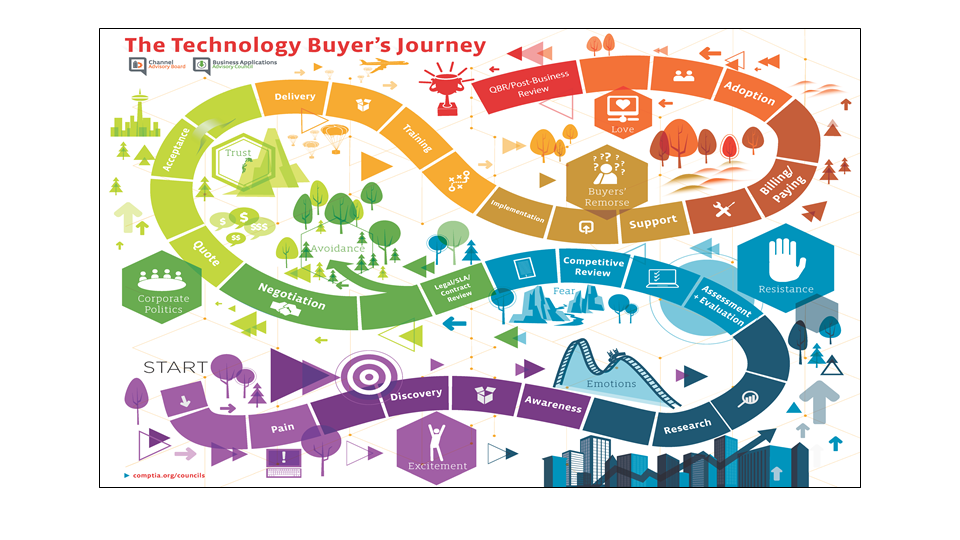
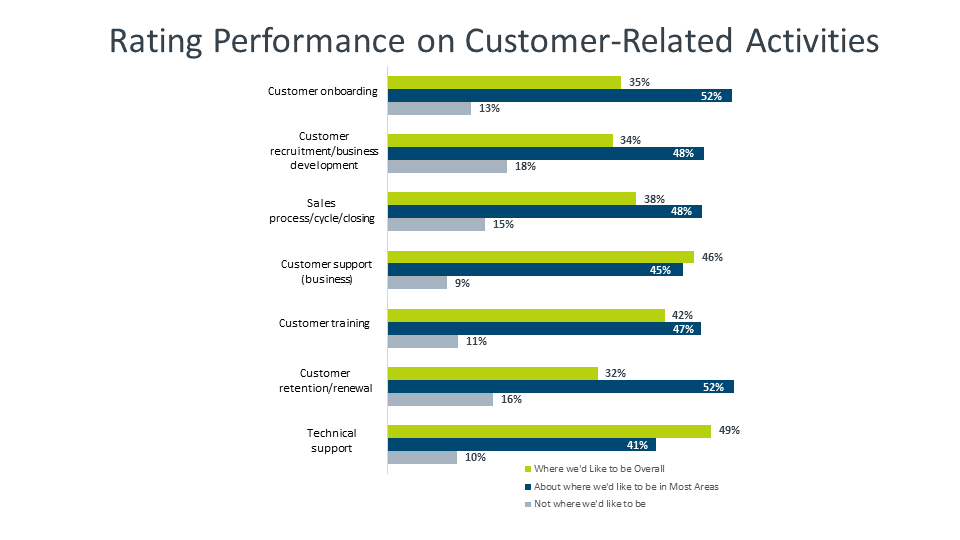
Acquiring keen customer insights should help firms reach their internal goals for a CX strategy. A recent Genesys study found that the top three motivations for working to improve CX are to improve customer retention (42%), boost customer satisfaction (33%), and increase cross- and up-selling opportunities (32%).
Of the customer activities channel firms are engaged in today, respondents feel they are doing the best job in the area of technical support. This is no surprise, given that technical acumen is their core mission. Organizations also give high marks to their performance with business-related support for customers that includes handling billing issues, contracts, etc.
On the negative side, two customer-focused areas where the most respondents reported deficiencies serve as literal bookend activities in the customer relationship. At the front end are customer recruitment and business development efforts, which 18% of respondents said are lacking and need improvement. At the back end, 16% expressed concern about renewal and retention; in other words, holding onto existing clients.
A few things explain why these two areas stand out as particular challenges: insufficient staffing in requisite job roles, lack of formal processes, a need for more training, etc. And there are general resource struggles most small firms face, particularly among micro-sized firms with fewer than 10 employees.
Process Makes Perfect
As channel organizations strive to develop new ways to provide their customers with the most optimal buying and support experiences, it’s a good idea for them to look inward first. For many companies, this can be a painful reflective exercise. But like many self-assessments in business, it is better to gauge where you are at presently with specific operations before diving into something new; in this case, an emerging CRM tool, an updated sales methodology, or new management strategy for engaging with customers.
Underpinning these efforts is attention to process. First off, do you have any formal processes? Are they working? Are the various touchpoints and types of customer engagements in your business formalized and repeatable? Heavy formalization is often viewed as the domain of larger companies, especially at the enterprise level, but it is just as applicable and useful for smaller firms that comprise the majority of today’s channel ecosystem. Putting together a cohesive CX strategy is not simply for big players, but doing so does require attention to process by all.
The good news from the research is that the vast majority of channel firms today have at least some degree of formalization in place for the basic business actions that take place as part of customer relationship management. Predictably, some areas have been more formalized than others, namely customer support, which is so crucial to get right to retain clients. So in the two categories respondents gave their firms the highest marks for overall performance – customer technical and business support – they also report applying the strictest formalization of process. Forty-two percent of channel firms said that customer support for business tasks such as a billing, payment, contracts, legal, etc., is strictly formalized. Likewise, in the area of technical customer support, a third report having strict formalization in place today. These findings suggest a correlation between having codified, repeatable processes for certain operational functions and how well those functions then perform. In these two categories (tech support and business support), three quarters of respondents that have formal processes in place report them being either effective or very effective.
Across the various business models in the channel (solution provider, managed services, consulting, reseller, etc.), there was little difference in the degrees to which they formalize each operational process related to customers. However, in certain categories such as business-oriented customer support, respondents that sell managed, cloud, and/or emerging tech services reported greater formalization by about 5 percentage points on average over the other business models represented. This is in large part due to the recurring revenue nature of those businesses, where customers are placed on ongoing contracts and billed on a cyclical basis. That model is not unlike what consumers encounter with a utility company or cable operator.
A quarter of the sample reported little to no formalization of customer-related business activities. Their top three reasons were the lack of staff to focus on process (56%), being too busy running the day-to-day business (47%), and insufficient resources/costs too high (43%). Each of these reasons represent typical challenges for small and medium-sized firms in all industries, not just tech. In the channel sample, the largest firms were less likely to cite these inhibitors.
CX: Times Are a Changing
The monolithic, one-stop-shop approach to customer engagement began going out the window with the advent of the Internet. It’s only accelerated with the rise and impact of cloud computing, social media and now a host of emerging technologies that, among other things, fuel self-service procurement by clients. Toss in two generations of digital natives who crave personalization and flexibility in how they purchase goods and services and you have effectively ushered in a new mandate for customer-provider interactions.
This reality has not been lost on the IT channel ecosystem. Two thirds of respondents said the evolving demands of the customer experience have prompted them to make changes – some minor, others major – to their approach to client engagement and support. And nearly 3 in 10 are considering doing so. These adjustments run the gamut from retraining technical and sales staff on newer kinds of communications tools and techniques to redesigning Web sites to incorporate emerging technologies such as AI, chat bots and video.
Other changes are more human resources-intensive, such as hiring dedicated customer service reps, marketing, and social media professionals. These three job roles have historically been underrepresented at many channel firms, especially the smallest, yet they are critical to developing a strong CX strategy in today’s business environment. Consider the following: 61% of channel firms with fewer than 10 employees lack a single dedicated customer service representative, compared with 20% of the total sample in the same situation. And just half of all respondents employ a full-time marketing professional, while only 38% count a social media specialist as part of headcount. A dedicated social media employee is a key piece to the CX strategy today given that it is increasingly a preferred communications and marketing tool by many younger-generation customers.
So while it seems the channel is looking to go all-in on new approaches to CX, their aspirations for now might be in conflict with their resource capacity. Again, this isn’t surprising given that the channel ecosystem is overwhelmingly comprised of small and medium-sized businesses. Case in point: When it comes to main challenges in architecting a new CX strategy, respondents cited the lack of sufficient resources as the top inhibitor. Among medium and larger channel firms, resource constraint is cited as less of an issue. Many of these firms do have in place the requisite staff needed to address new CX initiatives.
And yet for smaller firms, the adage, “You have to spend money to make money” applies aptly to today’s customer engagement success. Practically, this means hiring people for job roles that most impact clients, such as service reps, business development specialists, and marketing and social media professionals. It also includes investments in training around new technology tools and sales tactics, among other commitments.
It all doesn’t have to happen at once, though. Like any significant business model shift – think the move from product sales to managed services, for example – it’s clear most SMBs will have to take baby steps.
Go to Market Strategies
Perhaps the biggest changes in how companies deliver on customer experience today involve communication and interaction options. The Internet era ushered in e-commerce and online shopping, while mobile devices have reinvented how consumers engage with service providers. Customers today want to be able to deal with their technology providers on any device they choose to use. For the channel, this has meant embracing an omnichannel approach to both communications and go-to-market delivery strategies.
Three in 10 respondents said they have moved to an omnichannel approach for interacting with customers in the last year. (Please see definition in righthand column.) That’s balanced almost equally by the number of channel firms that are taking a hybrid approach to their customer interactions (31%). But 4 in 10 still hew to their old ways, continuing to sell and engage with clients via one primary vehicle – think in-store sales or Web-site e-commerce only.
The smallest channel firms were most likely to be sticking to their traditional go-to-market and communications strategies, with just 20% of companies with fewer than 10 employees adopting an omnichannel approach. Again, this is largely a function of resources and the technical capabilities needed to support multiple customer devices, emerging tools, and other engagement and marketing preferences.
The move to using multiple channels to recruit new customers, communicate with existing ones, and sell to all, is largely driven by customer demand for flexibility, but also marks a competitive play by providers looking to cast an appealing and much wider net for sales and engagement.

- Omnichannel approach: Offer a variety of options from in-store experience to traditional e-commerce to online customization of products/services. Enable purchasing via chat/video chat, email, social media, and other platforms. Communications are transferrable across multiple devices, including in the midst of a transaction.
- Traditional, uniform approach: Typically sell products and services to customers via one PRIMARY vehicle/method. (i.e. e-commerce, inbound sales, managed accounts)
- Hybrid approach: Lean heavily toward the traditional go-to-market models, but are morphing toward an omnichannel, multi-device/experience approach.
Challenges exist when adopting a multipronged approach. For nearly half of respondents (48%), the main obstacle to an omnichannel strategy is the technical support requirement that goes along with it. This is largely a resource issue, having the tools, platforms and people in place to support multiple customer touchpoints and to incorporate the use of newer tools such as artificial intelligence chatbots and data analytics that help personalize the customer experience.
Another 4 in 10 respondents piggybacked on their No. 1 challenge by citing the learning-curve difficulties involved in new collaboration and communications tools. And it’s not just technical challenges; 36% of firms said retraining their sales staff presented a hurdle.
Web site redesign was also high up on the omnichannel challenge list, with a third of respondents singling it out as one of their tough tasks. Difficult – and expensive – as it may be, however, Web site overhauls are a critical piece of today’s updated CX strategy. Most of the channel seems to recognize this. Consider that three quarters of respondents said they have done some degree of Web site redesign in the last year, including half who underwent a major redesign and 16% who did a complete platform/infrastructure overhaul of their sites.
Drilling down, the specific reasons channel firms chose to update or overhaul their Web sites in the last year were to improve navigation (55%), increase sales and brand awareness (50%), add interactivity features to improve customer engagement (46%), refresh a long-overdue site (42%), increase online sales specifically (38%), and add a customer review section (23%).
Asked if their company had received a negative customer review on either their own site’s comments section or a third-party review site in the last year, 23% said that they had. Nearly all of those affected firms (20%) said they conducted some sort of corrective action or customer outreach as a result of the negative reviews.
Metrics Matter
In 2005, Bain & Co. studied a phenomenon known as the “delivery gap” in customer service. What they found was astonishing. Of the companies Bain surveyed, 80% said they believed they provided a “superior” proposition/service to their customers. So Bain asked their customers if that were true; just 8% agreed. This perception chasm has been cited myriad times over the years as the single greatest customer service statistic in the world.
Is it still the case today? That’s debatable. In today’s rapid-change, multichannel environment, you could argue customer service has gotten better as options for engagement have expanded and speed to resolution has gone up. You could also make a case they’ve gotten worse because of the added complexity that new technologies and tools bring to the table.
Metrics, just like process formalization, are the only quantifiable way to accurately assess the job your firm is doing with its customers. For modern-day CX assessment, there are a wide variety of metrics vehicles that channel firms are using. The age-tested customer satisfaction survey still reigns as the preferred feedback tool, with 4 in 10 respondents saying they issue an annual one. Increasingly, however, different types of calculus are being applied. For example, 37% of respondents are judging their CX performance based on the level of engagement they have with individual clients. Is it one-time opportunistic or repeat business with more depth? Others (35%) are paying attention to what their customers are saying about them online and to other consumers.
Actions Taken Based on Measuring CX
36% Elevated use of social media for marketing and customer communications
31% Retrained customer service staff
28% Implemented personal algorithms to tailor a preferred experience for individual
customers
26% Implemented CRM, marketing automation and/or data analytics tools (packaged or cloud)
26% Hired dedicated marketing professional
23% Adjusted service level agreements
for recurring revenue customers
22% Implemented emerging tech tools such as artificial intelligence-based chat and video bots, gamification for customer surveys and purchase paths, etc.
19% Implemented new
shipping, delivery and/or return policies
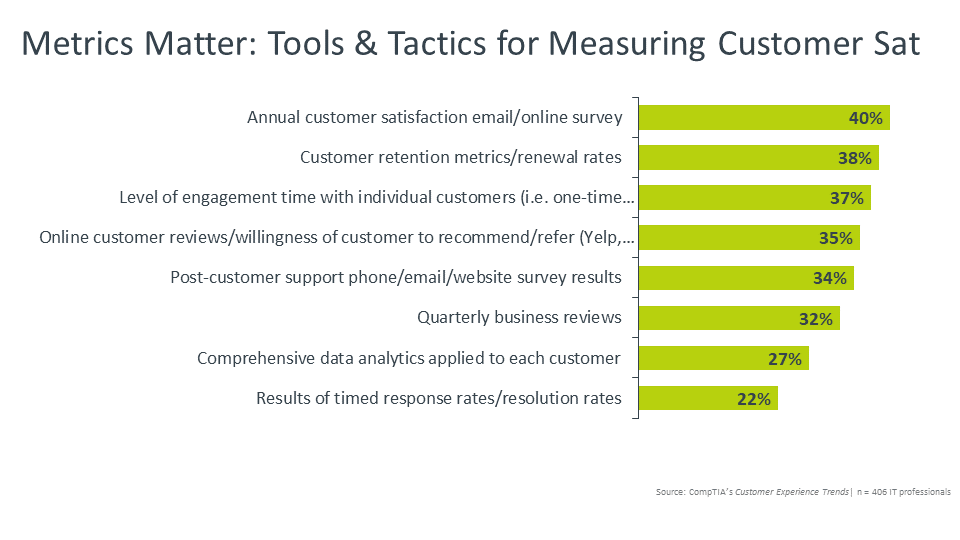
Still others are beginning to see the importance of data analytics. Twenty-seven percent of channel firms are applying analytics to every customer, measuring everything from what industry they hail from to the size of their business to their preferred methods of engagement via sales and marketing. And it’s paying off for most: 55% of firms rated analytics as “very useful” in measuring and improving CX.
The analytics findings in this study dovetail with recent data from CompTIA’s IT Industry Outlook 2019 study that found that 46% of channel firms plan to focus on personalization efforts this year. These initiatives involve tailoring experiences, content and engagement strategies to individual customer preferences. The current catchword for this is “hyper-personalization.” Already widely used in the retail and content marketing industries today, hyper-personalization in the year ahead can become a differentiator for many channel firms. It’s already begun, in fact. Nearly 3 in 10 channel firms said they implemented personalized algorithms to craft a preferred experience for individual customers last year, including a whopping 43% of medium-sized companies with between 100-499 employees.
Today, just 22% of channel firms are incorporating emerging technologies as part of their customer engagement, but that percentage should increase over the next year or two based on research that demonstrates a clear interest in these tools by the ecosystem. AI-related chat-bots and video-bots will play an increasingly large role in customer service tasks, while methods such as gamification – which appeals to younger-generation clients – are beginning to be used to collect customer feedback in lieu of more traditional survey instruments.
Finally, channel firms aren’t the only group thinking about improving CX. Their customers are looking to do so in their own businesses. In CompTIA’s recent study, Tech Buying Trends Among Small- & Medium-Size Businesses, CX was cited as the No. 1 priority for tech spending among end users.
Appendix
Research Methodology
This quantitative study consisted of an online survey fielded in April-May 2019 to 406 U.S. IT businesses, yielding an overall margin of sampling error proxy at 95% confidence of +/- 4.9 percentage points. Sampling error is larger for subgroups of the data.
As with any survey, sampling error is only one source of possible error. While non-sampling error cannot be accurately calculated, precautionary steps were taken in all phases of the survey design, collection and processing of the data to minimize its influence.
CompTIA is responsible for all content and analysis. Any questions regarding the study should be directed to CompTIA Research and Market Intelligence staff at [email protected].
CompTIA is a member of the market research industry’s Insights Association and adheres to its internationally respected Code of Standards.
Read more about Industry Trends.


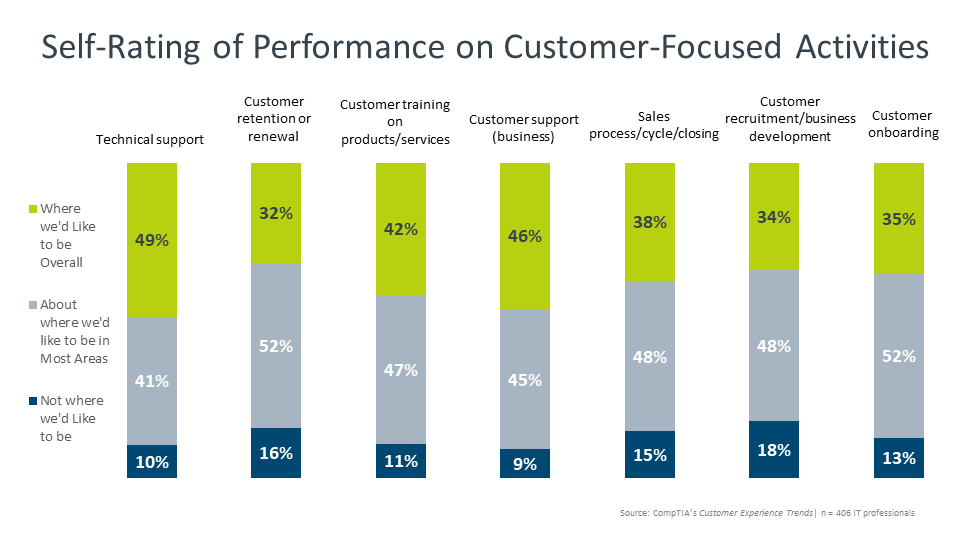
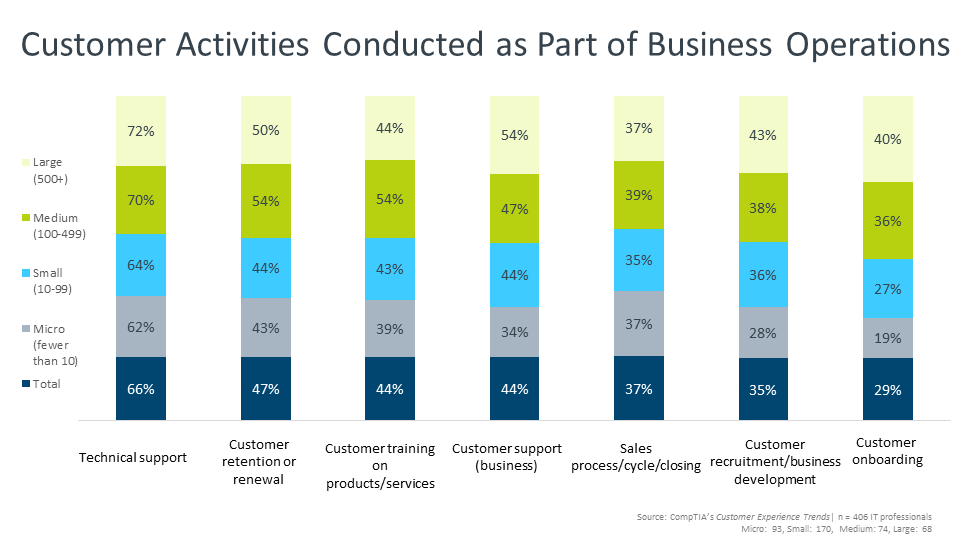
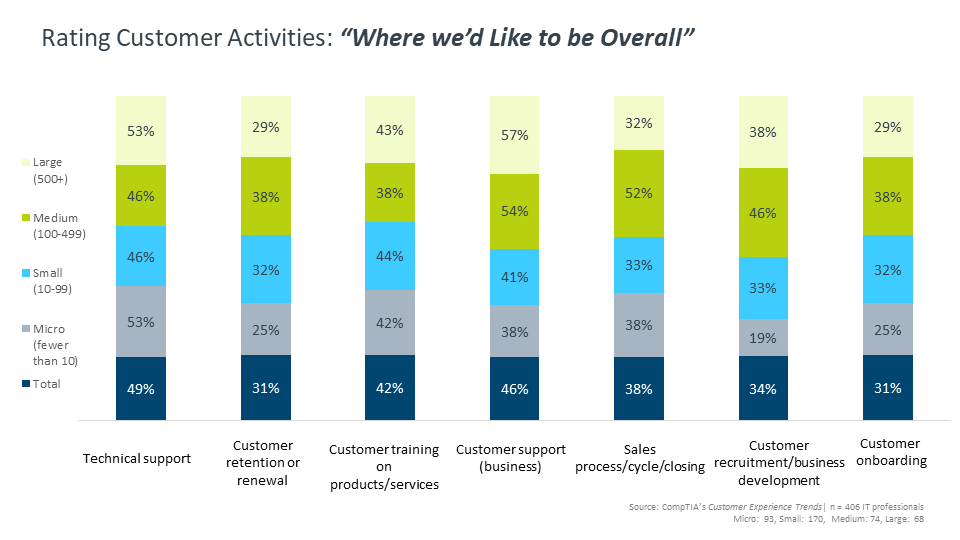
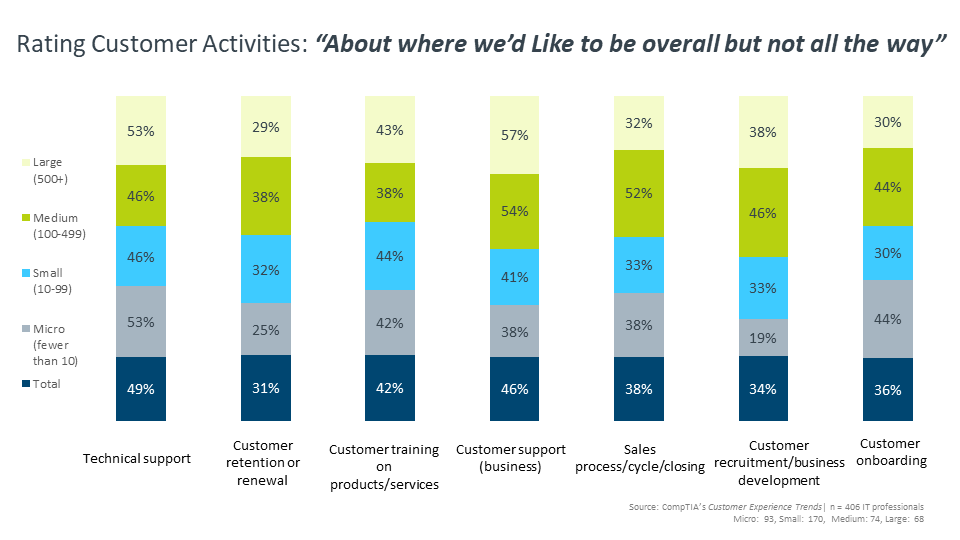
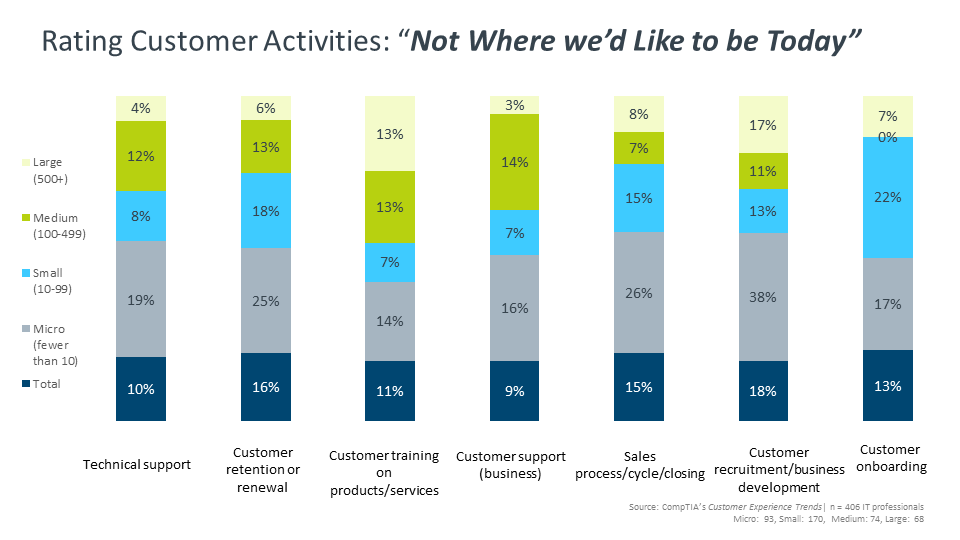
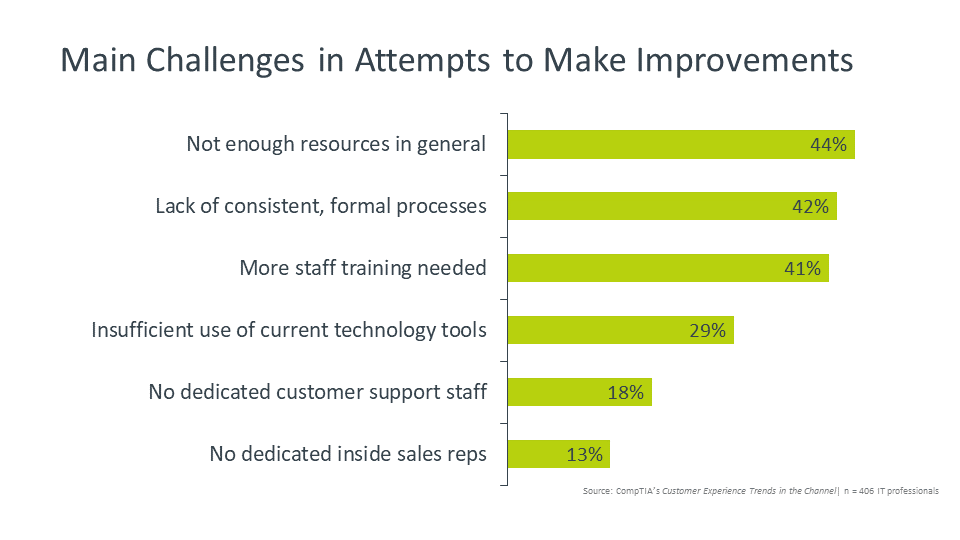

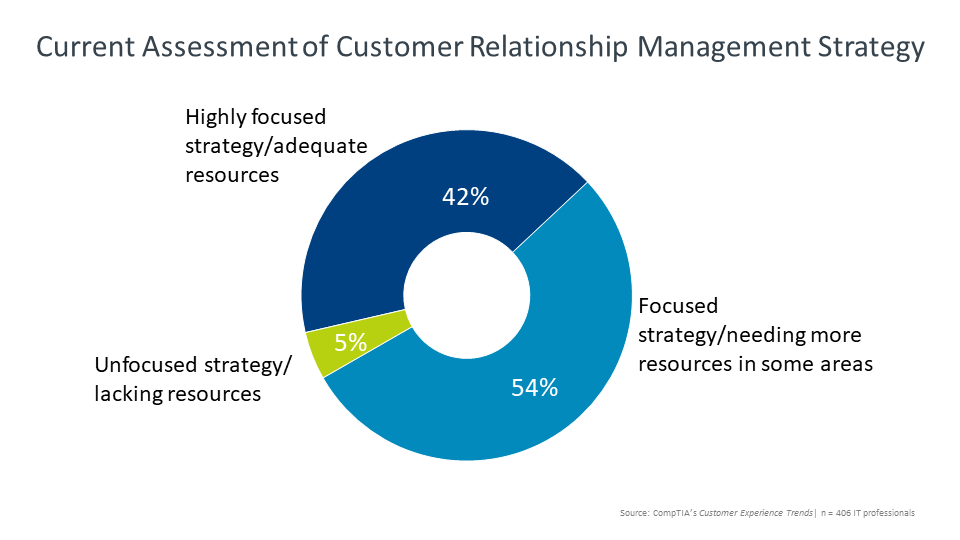
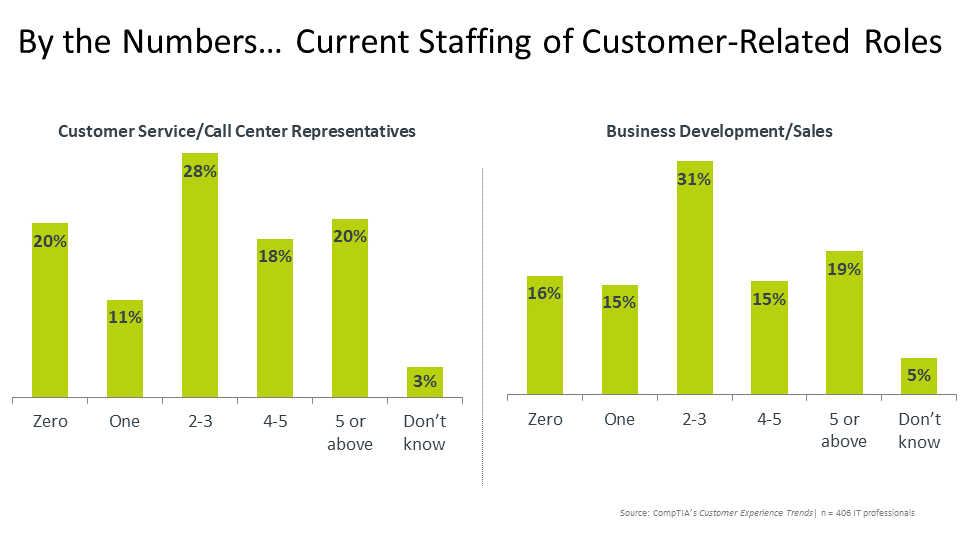


.png?sfvrsn=ef47326f_4)

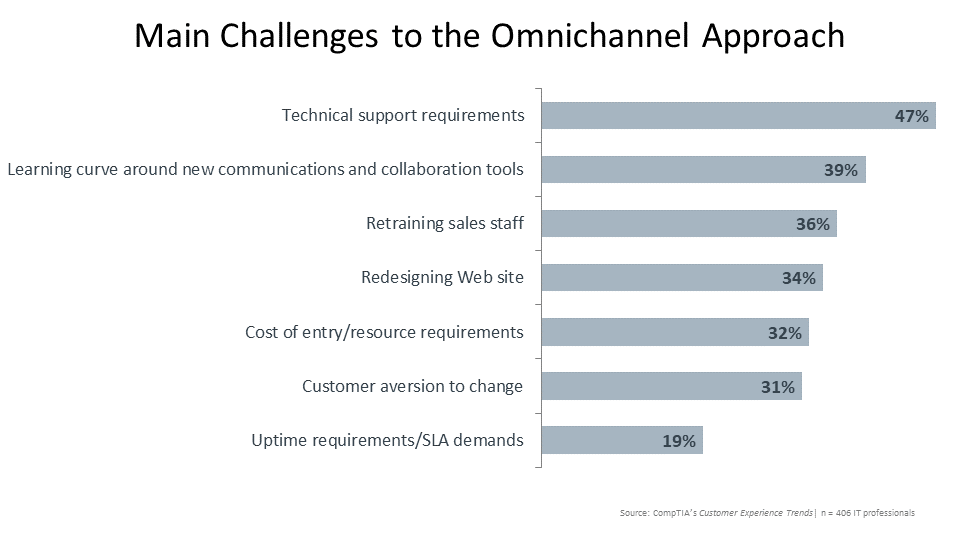
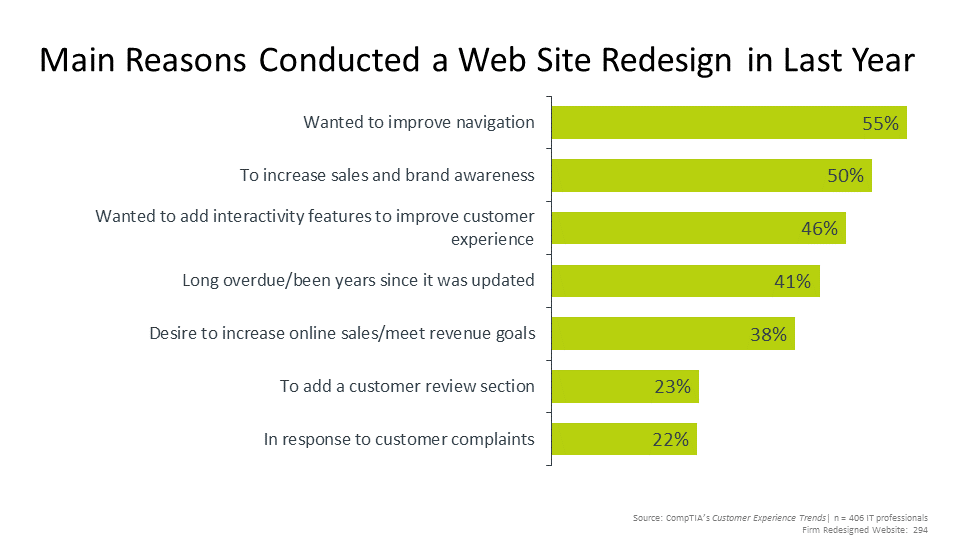
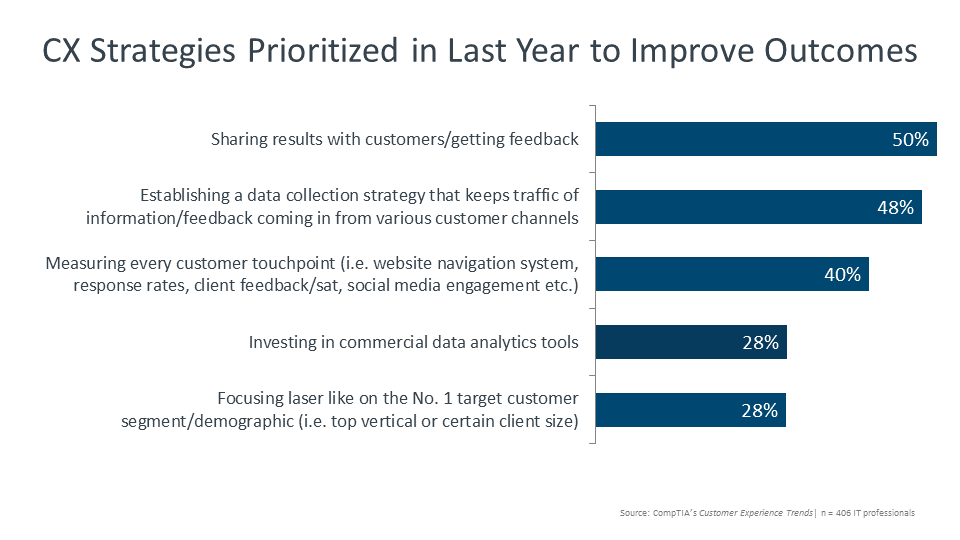
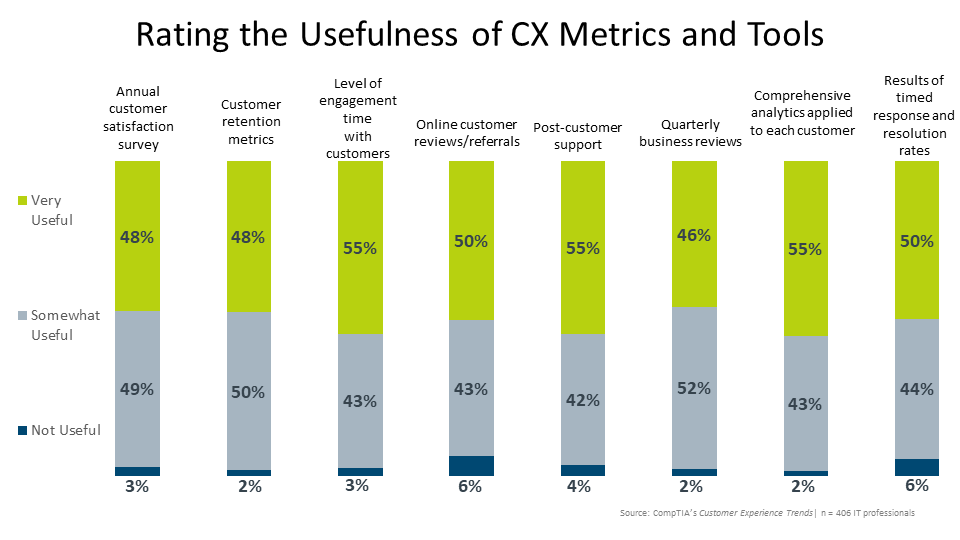
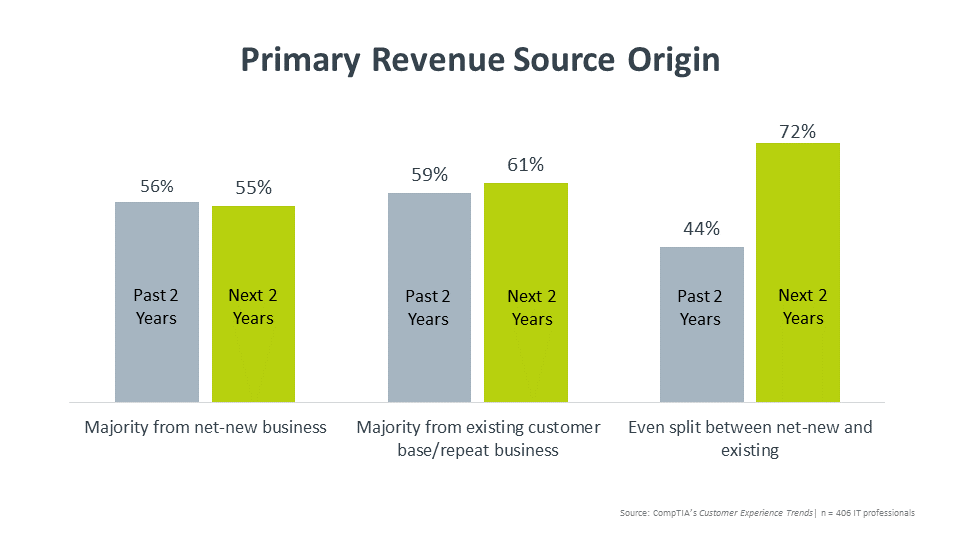

 Download Full PDF
Download Full PDF